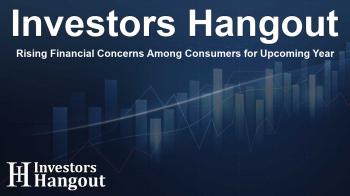Rising Financial Concerns Among Consumers for Upcoming Year

Growing Anxiety Over Unexpected Expenses
Recent research highlights a worrying trend among consumers. More than half, 53%, express concern regarding their ability to afford surprise expenses as economic uncertainties loom. This new study emphasizes how rising costs are prompting shifts in financial behaviors, compelling consumers to rethink how they manage their finances.
Understanding the Financial Landscape
According to a comprehensive survey conducted by Splitit and PYMNTS, the landscape of American consumer finances is rapidly changing. The study surveyed over 7,000 individuals and uncovered significant insights into their financial habits amid rising economic pressures. As consumers face various challenges, the report sheds light on how unexpected expenses, such as emergency repairs, weigh heavily on household budgets.
The Impact of Emergency Expenses
Unplanned costs can have a substantial financial impact. A staggering 42.9% of respondents noted that emergency car repairs constitute a significant portion of unexpected expenses, while 34.3% pointed to home repair costs. This financial burden is not trivial; the median spend on home repairs alone stands at around $2,112. Interestingly, despite the growing popularity of Buy Now, Pay Later (BNPL) solutions, only 9% of consumers reported utilizing it for these emergency costs, with many resorting to credit cards instead.
Adjusting Consumer Behavior in Uncertain Times
Nandan Sheth, CEO of Splitit, stated that the current market conditions are causing consumers to adopt a more strategic approach toward managing unexpected expenses. He mentions that with credit card-linked installments becoming more popular, consumers can use their existing credit lines while maintaining flexibility. This is a critical tactic during uncertain economic times.
Key Findings from the Study
Delving deeper into the study's findings reveals several crucial trends:
- $605 is the median cost for emergency purchases exceeding $250.
- 50% of consumers reported that the rising cost of goods would make them reduce impulse buying this year.
- Gen Z emerges as the most concerned group, with 63% apprehensive about covering unexpected expenses.
- 36% of respondents indicated they had made an impulse purchase of at least $250 in the past three months.
- 33% of consumers predominantly used credit cards for their last emergency spending.
- 45% of users of BNPL stated that the approval of their purchase was a significant motivation for using this method.
- 48% of consumers who made impulse buys with credit cards paid them off entirely by the next statement.
- 24% of Gen Z consumers opt for merchant-offered installment plans, highlighting their preference for flexible payment options.
The Shift Toward Flexible Payment Options
The inclination toward credit card-linked installment payments is evident across different generations. Many consumers are eager for greater control over their purchasing decisions. As financial uncertainty continues, the relevance of flexible payment solutions is expected to grow.
A Paradox in Consumer Spending
Despite the emphasis on financial caution, data indicates that approximately half of shoppers engaged in unplanned purchases over the past year. This reveals a fascinating paradox where, although consumers are conscious of potential economic pitfalls, they continue to be drawn to spontaneous purchases driven by emotional triggers and contemporary social influences.
Conclusion
As we navigate this changing economic landscape, understanding these consumer trends is essential for businesses. By recognizing the importance of affordability and offering flexible payment options, brands can better connect with their target audiences, addressing the challenges presented by both impulsive buying behaviors and financial strain.
Frequently Asked Questions
What percentage of Americans are worried about unexpected expenses?
Over 53% of consumers are concerned about affording unexpected expenses due to economic uncertainties.
What are the most common unplanned expenses?
Common unplanned expenses include emergency car repairs and home repair costs.
How do consumers prefer to cover unexpected costs?
Many consumers rely on credit cards, while a smaller percentage use Buy Now, Pay Later solutions.
What impact does economic uncertainty have on consumer behavior?
Economic uncertainty leads consumers to become more strategic in handling their finances, preferring flexible payment options.
Which demographic shows the greatest concern about unexpected expenses?
Gen Z exhibits the highest concern, with 63% anxious about covering unexpected costs.
About The Author
Contact Logan Wright privately here. Or send an email with ATTN: Logan Wright as the subject to contact@investorshangout.com.
About Investors Hangout
Investors Hangout is a leading online stock forum for financial discussion and learning, offering a wide range of free tools and resources. It draws in traders of all levels, who exchange market knowledge, investigate trading tactics, and keep an eye on industry developments in real time. Featuring financial articles, stock message boards, quotes, charts, company profiles, and live news updates. Through cooperative learning and a wealth of informational resources, it helps users from novices creating their first portfolios to experts honing their techniques. Join Investors Hangout today: https://investorshangout.com/
The content of this article is based on factual, publicly available information and does not represent legal, financial, or investment advice. Investors Hangout does not offer financial advice, and the author is not a licensed financial advisor. Consult a qualified advisor before making any financial or investment decisions based on this article. This article should not be considered advice to purchase, sell, or hold any securities or other investments. If any of the material provided here is inaccurate, please contact us for corrections.

